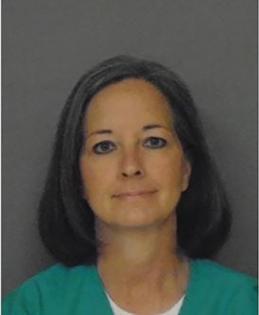South Carolina child killer Susan Smith seeks parole. Was she a victim like her boys or a manipulator?
Published in News & Features
COLUMBIA, S.C. — When Susan Smith walked into the courtroom in Union County to learn whether she would live or die for killing her young sons, it signified the end of nine months of a town split apart by an act so heinous people could not imagine it happened there.
The media was everywhere, restaurants to beauty shops, Main Street to John D. Long Lake, where Smith on Oct. 25, 1994 slipped off the hand brake on her Mazda Protege to let Michael, 3, and Alex, 14 months, roll into the chilly water strapped in their car seats.
They ended up upside down, hanging, in 18 feet of water. And stayed there for nine days until Smith was cajoled into confessing what she had done to them. Her story at first was that a black man had forced her from her car with the boys in the back seat and sped off into the night.
Her lie set off a nine-day manhunt that brought simmering racial tensions to the fore in a town where her family was prominent. Her stepfather was a nephew to a former South Carolina governor. They had money and power.
But soon all the family secrets would become known, secrets about adultery and child molestation and a long family history of mental health problems.
People wondered if Susan Smith was a cold and calculating child killer or was as much of a victim as her children.
She’s been in prison for 30 years. Wednesday she will find out whether she will be freed.
Susan Smith’s background
Susan Smith, born Susan Leigh Vaughan, is the youngest of three children of Linda and Harry Vaughan. It was an unhappy marriage, but Susan was especially close to her father, who worked in a local textile mill.
For years, Smith kept an 8-by-10 photograph of her father, his coin collection and a tape recording of him trying to teach her how to talk.
Susan was 6 when her mother filed for divorce. A few months later, her father, Harry Vaughan shot himself in the chest and died.
A relative dropped Susan off after school that day. No one was home. They were dealing with Vaughan’s suicide. Susan was an afterthought.
In his closing statement in the penalty phase of the trial, her lawyer David Bruck put it this way, “Little 6-and-a-half-year-old Susan Vaughan had this whole sense that there was something secret about what had happened with her father’s death. It was not talked about. She cried alone. She mourned her father alone.”
Increasingly, Smith became obsessed with suicide. Her first attempt was when she was 13. She took aspirin. A second attempt was when she was 18. A court brief says she again took aspirin and Anacin and was hospitalized at Spartanburg Regional Hospital for a week.
When she was 15 years old, Smith was molested by her stepfather Beverly Russell, who had married her mother in 1979, seven years earlier. He was a member of the Christian Coalition, a leader in the local Republican Party and a supporter of Pat Robertson.
Family Court records showed Russell admitted to kissing her and fondling her breasts. Susan and her mother did not press charges, but the Russells separated. He mortgaged his house to pay Bruck’s fee.
Court testimony revealed the relationship with Russell continued for many years even after she married David Smith.
They met working at Winn Dixie when she was 19 and he was 20. She was two months pregnant with Michael when they married in March 1991.
The relationship was as unhappy as Susan Smith’s parents’ marriage had been. They separated, got back together. Both admitted to affairs.
In the months before the boys’ deaths, Susan Smith had been involved with Tom Findlay, who figured prominently into the trial because he broke off their relationship, telling Smith in a letter he did not want a ready-made family.
She countered that she had been sleeping with his father who was also her boss. She later said it was a lie.
The murders
On Oct. 25, 1995, Susan Smith picked her sons up from daycare. She had had several conversations with Findlay at his work. He was resolute. They could be friends but no more.
She went back after work while a friend watched the boys. He ushered her from his office. She told the friend she might end it all. The friend did not take her seriously.
Smith went home, packed a diaper bag for the boys to take a bath at her mother’s, but found out Linda Russell was going to a t-ball game for a grandson.
Instead, Smith drove around the Union County countryside.
She turned into the entrance to John D. Long lake, pulled her car to the top of the boat ramp. She was 23 and her life was a mess. Her boys would be better off dying with her in the lake.
Darkness surrounded her. She let the car go down the ramp. Abruptly she stopped. She got out. Then reached inside and let off the brake.
Her boys slipped off into the dark water.
She ran to the closest house. It was about 9 p.m. Shirley McCloud heard someone crying on her porch.
“Please help me! He’s got my kids and he’s got my car,” Smith told McCloud. “A Black man has got my kids and my car.”
Law enforcement arrived quickly. A search was begun. Smith’s mother arrived and went straight to her daughter and said, “I told you to lock your doors.”
Over the next days, Susan and David Smith appeared in press conferences and on TV to beg the kidnapper to bring back the boys. Susan Smith told a WYFF reporter the man had a gun in her side and when he forced her out of the car he told her he didn’t have time for her to get the boys but he wouldn’t hurt them.
Sheriff Howard Wells and other investigators suspected the story almost immediately. They worked to break her down. Finally on the ninth day, Wells took her hands as they sat in a common room at the First Baptist Church and told her to tell the truth. It was time. She asked for his gun.
Finally she told investigators where the boys were.
The trial
The trial began on a steamy July day. Prosecutor Tommy Pope, now a state representative, was going for the death penalty. The law was clear. If you kill more than one person and they were children, such a penalty was allowed.
During the guilt phase, Pope laid out his case, calling the ex-boyfriend, the investigators. It was clear she had killed them. She confessed to it.
Assistant Solicitor Barney Giese put the state’s case simply. She didn’t care for the children. She wanted something more, and they were in the way.
Among the most moving testimony came from a diver who found the bodies. He said he swam up to the window and saw a small hand pressed against the window. He gave a thumbs up to others, left the lake and cried on the bank. He had a son at home.
The jury took 2.5 hours to impose a guilty verdict.
Next came the penalty phase. Bruck and co-counsel Judy Clarke offered relatives, friends, coworkers, who all said Smith adored her children. They had no explanation for what happened, but they were well taken care of. Even the pathologist who examined them said that.
“They were all of her identity,” Bruck said in his closing statement. “They were all she was.”
Again, friends and family members asked for her life to be spared. Doctors and other specialists reported their findings in hours of interviews.
“We want to be sure that you know everything about what was weak about Susan, about why she broke under pressures that would only make most people bend,” Bruck said.
Again, 2.5 hours of deliberation led the jury to vote to spare her life.
The parole hearing
The seven-member South Carolina Department of Probation, Parole and Pardon Services’ will meet Wednesday to hear Smith’s application. She will appear via video conference.
Among those who are expected to ask the board to turn down her request are Smith’s ex-husband, David Smith. He has said 30 years are not enough.
Tommy Pope will also ask for parole to be denied.
He told The State’s Tracy Glantz he considers it a loss he was not able to secure the death penalty.
“I saw her behavior in the courtroom, she’d be giggling and laughing when the jury wasn’t in and crying when the jury came in, I saw a much more manifest, manipulative part of Susan,” he said.
“She is truly focused on Susan, that she is either the princess or the victim. And again, not here to tell you how she got wired that way, but just saying that’s who we’re dealing with. And so in a strange way, I feel, if it’s possible, stronger about her need to remain incarcerated now than perhaps even at the trial, even though, of course, I was seeking the death penalty.”
State law says at least two-thirds of the panel must vote to approve and she must have employment and a residence. The board approves about 8% of the applications it receives. If it says no, Smith can reapply every two years.
Looking back, Bruck said he still believes everything he said during the trial.
A troubled young woman did a terrible thing.
_____
©2024 The State. Visit thestate.com. Distributed by Tribune Content Agency, LLC.







Comments